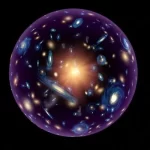Key Takeaways:
-
It proposes the universe has properties allowing observers to exist, explaining why physical constants seem fine-tuned for life.
-
Many believed a 2+1 dimensional universe couldn’t support life due to limitations with gravity and complexity.
-
James Scargill’s work shows a 2+1 universe could have gravity and complexity through specific network structures.
-
The physics in universes with 4+ spatial dimensions or just 2 spatial dimensions might not allow stable structures or complex life.
-
While 2+1 dimensions might hold potential, Scargill acknowledges more research is needed to confirm if his network models can replicate the complexity of living organisms.
Why do we live in a universe with three dimensions of space and one of time—3+1 dimensions, as cosmologists would say? What about another combination, like two dimensions of time or four dimensions of space?
In order to determine whether complex life could exist in other universes, physicists have been examining the properties of those universes in recent decades. They conclude that it is not possible for it to exist in a four-dimensional universe or a universe with more than one time dimension. Accordingly, it is inevitable that humanity exists in a 3+1-dimensional universe.
This is known as the anthropic argument—the idea that the universe must have the properties necessary for observers to survive.
But what of simpler universes, such as one with 2+1 dimensions? Scientists have long believed that life could not exist in two spatial dimensions due to the inability to support such complexity. They also believe that two-dimensional objects could not form because gravity would not function in that context. But is that really true?
Thanks to James Scargill’s research at the University of California, Davis, we now know that a 2+1-dimensional universe is capable of supporting both gravity and the complexity necessary for life, despite all expectations. For cosmologists and philosophers, the work undermines the anthropic argument, forcing them to come up with a different explanation for why the universe is structured the way it is.
First some background. The reason why the laws of physics seem to be optimized for life is one of the great scientific mysteries. For instance, the fine-structure constant’s numerical value of 1/137 appears arbitrary, but several physicists have noted that atoms and other more complex objects could not form if it were even somewhat different. A universe like that could not support life.
The anthropic approach is to argue that if the fine-structure constant took any other value, there could be no observers to measure it. It has the value we measure because of this!
A physicist who is currently at MIT, Max Tegmark, developed a similar case for the number of dimensions in the universe in the 1990s. He maintained that the laws of physics would not have the characteristics that allow observers to predict the existence of more than one temporal dimension. That appears to rule out both life itself and the existence of physicists.
Next are the characteristics of four-dimensional universes. Newton’s laws of motion would be extremely sensitive to even the smallest perturbations in this type of universe. One consequence is that stable orbits could not form, so there would be no solar systems or other similar structures. “In a space with more than three dimensions, there can be no traditional atoms and perhaps no stable structures,” said Tegmark.
Therefore, it appears unlikely that life could exist in universes with more dimensions than our own. Less secure universes with fewer dimensions, however, are the argument.
One argument is that gravity cannot exist because general relativity cannot function in two dimensions.
However, James Scargill believes differently. He demonstrates in today’s paper that a two-dimensional, purely scalar gravitational field would be feasible, allowing for stable orbits and a probable cosmology.
But his more impressive result is to show how complexity could emerge in 2 +1 dimensions. Scargill addresses this issue from a neural network perspective. He makes the point that a variety of unique characteristics that any 2D system must be able reproduce can be used to characterize the complexity of biological neural networks.
One of these is the “small world” property, which refers to a pattern of connectivity that enables one to navigate a complicated network in a limited number of steps. An additional characteristic of brain networks is that they function within a criticality regime, which is characterized by a careful balancing act between periods of high and low activity. And this also seems possible only in networks that have a modular hierarchy in which small subnetworks combine to form larger networks.
Therefore, Scargill queries whether any 2D networks possess all of these characteristics, including critical behavior, modular hierarchy, and small-world properties.
This initially looks impossible because nodes in 2D graphs are connected by connecting edges. Scargill does, however, demonstrate that 2D networks can be constructed modularly and that these graphs have specific small-world characteristics.
He also shows that these networks can operate at the transition point between two types of behavior and therefore demonstrate criticality. They are roughly “small-world,” he says, with a modular and hierarchical structure, and they exhibit [critical behavior] for specific stochastic processes.
That’s an intriguing outcome. It implies that surprisingly complex behavior can be supported by 2D networks. It is not, of course, evidence that life could exist in a 2+1 universe. In fact, Scargill notes that further research is necessary to determine whether the kinds of 2D networks he describes are able to exhibit the complex behavior found in living organisms. “More work is needed to compare the graphs presented here with real-life neural networks,” he says.
But it gives the lie to claims that 2+1 universe could not support life. It will take some more careful consideration on the part of the cosmologists and philosophers who support the anthropic principle.
Ref: arxiv.org/abs/1906.05336 : Can Life Exist in 2 + 1 Dimensions?


